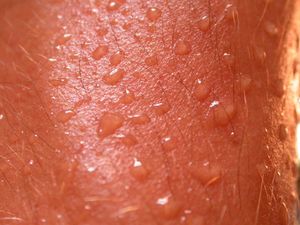Compensatory sweating
by Dietmar Stattkus (comments: 0)

Recently, the problem of compensatory sweating has been studied in the context of the use of deodorants. In this context, this particular phenomenon occurs predominantly postoperatively, after sympathectomy or nerve blockade, or even after surgical procedures under the arms by suction or laser treatment, and not infrequently even after effective iontophoresis therapy.
Compensatory sweating
Compensation commonly means as much as substitution, compensation. In the medical sense, compensation stands for the balancing of a reduced performance of an organ by increased activity (Wikipedia). In this respect, compensatory sweating is a zonally displaced compensatory sweating. On the one hand, the secretion of sweat has been interrupted or inhibited, for example, by surgical measures, by medicinal or other drug-related (antiperspirants) interventions, but on the other hand, there is an autonomous compensation, a compensation of sweating because it is widely known that sweating is an essential basis of human life. With reference to perspiration, compensation means nothing other than that the sweat seeks another way of vital body cooling. The affected person, whose sweating under the arms, for example, was prevented by an operation or other intervention, sometimes sweats more in a completely different region of the body, such as the trunk, neck, back, buttocks or legs.
Zonal sweating shift
Symbolically, this is no different in function than interrupting, diverting or redirecting the natural course of a river. The water doesn't stop flowing, it just looks for another way, whether in a natural way or forced.
Compensatory sweating is very individual. It can also be completely absent in some people after a blockade or inhibition of sweat secretion as a result of a therapeutic intervention, depending on age, sex, physical constitution or choice of sweating therapy.
Nevertheless, KS can also lead to a high degree of suffering. If affected persons find themselves post-therapeutically in the belief that they have finally got their sweating problem under control, a new problem area follows secondarily.
And this in the consequence and intensity even so far that one is again therapeutically forced to the intervention, this time against the compensatory sweating and no longer against the primary sweat zone. Compensatory sweating can even be interpreted as secondary hyperhidrosis in a broader sense.
Very pronounced this phenomenon appears in connection with the surgical interventions of ETS or ESB.

